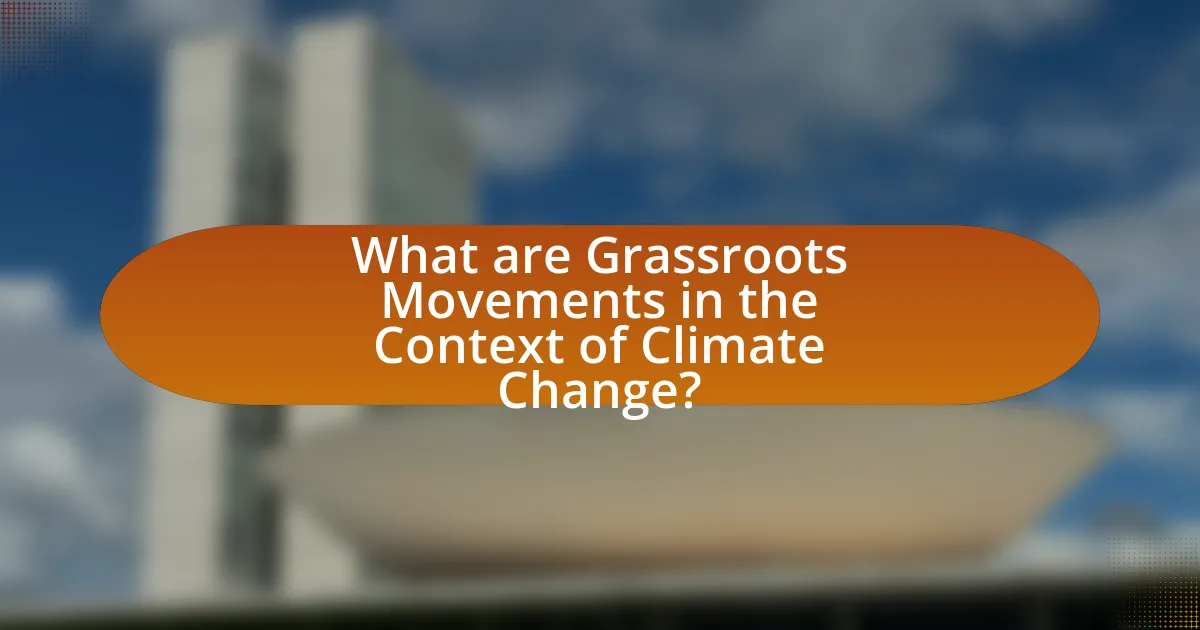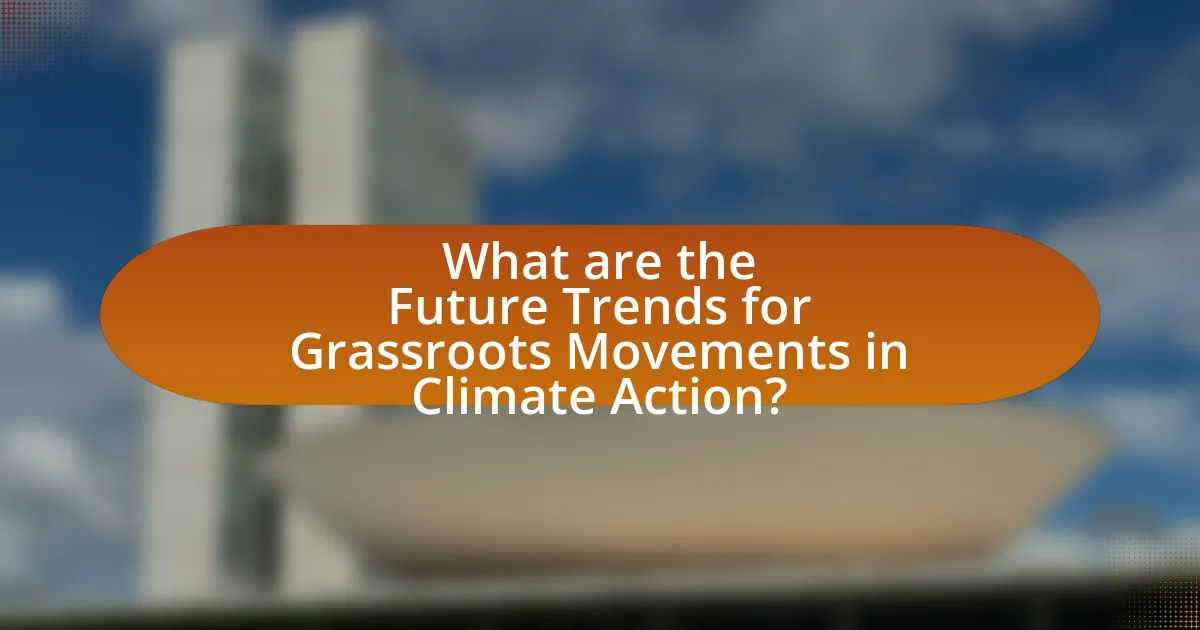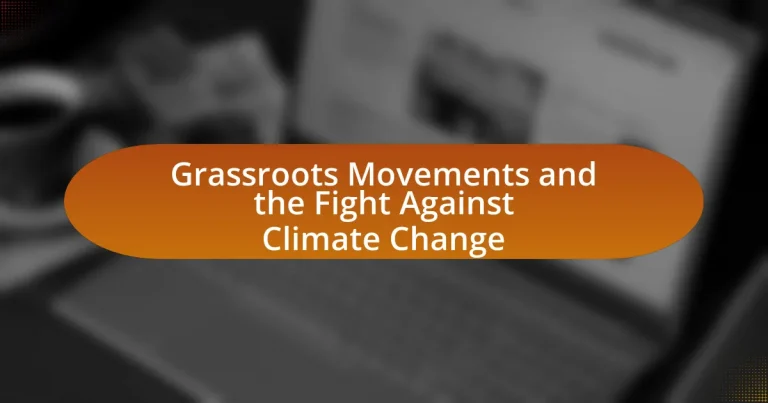Grassroots movements are community-driven initiatives that mobilize individuals to advocate for environmental justice and sustainable practices in the context of climate change. This article explores the characteristics, differences from traditional environmental organizations, and the essential role these movements play in climate action. It highlights successful examples of community-led initiatives, the influence of grassroots movements on policy and decision-making, and the challenges they face, including funding limitations and public engagement obstacles. Additionally, the article discusses the importance of collaboration with NGOs and the effective use of social media to enhance outreach and mobilization efforts.

What are Grassroots Movements in the Context of Climate Change?
Grassroots movements in the context of climate change are community-driven initiatives that mobilize individuals to advocate for environmental justice and sustainable practices. These movements often emerge from local communities and focus on raising awareness, influencing policy, and promoting action against climate change at the grassroots level. For example, the Sunrise Movement in the United States has successfully engaged young people to push for a Green New Deal, demonstrating the power of collective action in addressing climate issues. Such movements are crucial as they empower individuals to take ownership of climate action and create significant social and political change.
How do Grassroots Movements differ from traditional environmental organizations?
Grassroots movements differ from traditional environmental organizations primarily in their structure and approach to activism. Grassroots movements are typically community-driven, emphasizing local participation and direct action, while traditional environmental organizations often operate within established frameworks, focusing on policy advocacy and institutional engagement. For example, grassroots movements like the Sunrise Movement mobilize young people through local actions and direct engagement, contrasting with organizations like the Sierra Club, which may prioritize lobbying efforts and formal campaigns. This distinction highlights the grassroots emphasis on immediate, localized impact versus the broader, often slower processes of traditional organizations.
What are the key characteristics of Grassroots Movements?
Grassroots movements are characterized by their community-driven nature, local engagement, and emphasis on collective action. These movements typically arise from the grassroots level, meaning they originate from the community rather than being imposed by external organizations or authorities. They often focus on social, political, or environmental issues, mobilizing individuals to advocate for change through direct action, awareness campaigns, and community organizing.
Additionally, grassroots movements prioritize inclusivity and participation, encouraging diverse voices and perspectives within the community. They rely on volunteer efforts and grassroots funding, which distinguishes them from top-down initiatives that may have corporate or governmental backing. Historical examples, such as the Civil Rights Movement in the United States and the environmental activism seen in the Fridays for Future movement, illustrate how grassroots movements can effectively mobilize communities to address pressing issues, including climate change.
Why are Grassroots Movements essential for climate action?
Grassroots movements are essential for climate action because they mobilize local communities to advocate for sustainable practices and policies. These movements empower individuals to take collective action, often leading to significant changes at local, national, and global levels. For instance, the global climate strikes initiated by youth activists have raised awareness and pressured governments to commit to more ambitious climate goals, as evidenced by the increased participation in the United Nations Climate Change Conferences. Additionally, grassroots organizations often highlight the voices of marginalized communities disproportionately affected by climate change, ensuring that their needs and perspectives are included in climate discussions and solutions.
What role do local communities play in Grassroots Movements?
Local communities are essential in grassroots movements as they provide the foundational support, mobilization, and localized knowledge necessary for effective advocacy. These communities often identify specific environmental issues affecting their areas, such as pollution or deforestation, and organize collective actions to address them. For instance, the Standing Rock Sioux Tribe’s opposition to the Dakota Access Pipeline exemplifies how local communities can galvanize national attention and support for environmental justice. Their efforts highlighted the importance of indigenous rights and environmental protection, demonstrating that local voices can influence broader policy changes.
How do local initiatives contribute to broader climate goals?
Local initiatives contribute to broader climate goals by implementing sustainable practices that reduce greenhouse gas emissions and promote environmental stewardship. These grassroots movements often serve as testing grounds for innovative solutions, such as community solar projects or urban reforestation efforts, which can be scaled up to influence regional and national policies. For example, the 2019 Global Climate Strike, initiated by local youth activists, mobilized millions worldwide, demonstrating the power of local actions to drive global awareness and policy change. Additionally, local initiatives frequently engage communities in climate education, fostering a culture of sustainability that aligns with international climate agreements like the Paris Accord.
What are some successful examples of community-led climate initiatives?
Successful examples of community-led climate initiatives include the Transition Towns movement, which began in Totnes, England, and has spread globally, focusing on local resilience and sustainable practices. Another example is the Community Forests initiative in the United States, where local communities manage forests to enhance biodiversity and combat climate change. Additionally, the Solarize campaigns in various U.S. cities have successfully mobilized neighborhoods to adopt solar energy collectively, resulting in significant reductions in carbon emissions. These initiatives demonstrate the effectiveness of grassroots efforts in addressing climate challenges through localized action and community engagement.
How do Grassroots Movements influence policy and decision-making?
Grassroots movements influence policy and decision-making by mobilizing community engagement and raising awareness about specific issues, particularly in the context of climate change. These movements often utilize social media and local organizing to amplify their messages, leading to increased public pressure on policymakers. For example, the global climate strikes initiated by youth activists in 2019, inspired by Greta Thunberg, resulted in significant political responses, including commitments from various governments to enhance climate action. Research indicates that grassroots advocacy can lead to legislative changes, as seen in the U.S. with the Green New Deal gaining traction due to grassroots support. This demonstrates that grassroots movements can effectively shape policy agendas and influence decision-making processes at multiple levels.
What strategies do Grassroots Movements use to advocate for change?
Grassroots movements advocate for change through community organizing, direct action, and public awareness campaigns. Community organizing involves mobilizing local individuals to collectively address issues, fostering a sense of ownership and empowerment. Direct action includes protests, sit-ins, and other forms of civil disobedience to draw attention to specific causes, exemplified by movements like Fridays for Future, which has galvanized youth participation in climate activism. Public awareness campaigns utilize social media and traditional media to disseminate information, raise consciousness, and influence public opinion, as seen in the widespread use of hashtags and viral content to promote climate action. These strategies are effective in creating a collective voice that can influence policy and societal norms.
How can Grassroots Movements hold governments accountable?
Grassroots movements can hold governments accountable by mobilizing public opinion and advocating for policy changes. These movements often utilize social media and community organizing to raise awareness about climate issues, thereby pressuring governments to act. For instance, the Fridays for Future movement, initiated by Greta Thunberg, has successfully influenced climate policy discussions in various countries, demonstrating the power of collective action. Additionally, grassroots organizations can engage in legal actions, such as lawsuits against governments for failing to meet environmental regulations, as seen in cases like Juliana v. United States, where youth plaintiffs argued for their right to a stable climate. This combination of advocacy, public mobilization, and legal action creates a framework for holding governments accountable to their climate commitments.
What challenges do Grassroots Movements face in the fight against climate change?
Grassroots movements face significant challenges in the fight against climate change, including limited funding, lack of political influence, and difficulties in mobilizing widespread public support. Limited funding restricts their ability to implement projects and campaigns effectively, as many rely on small donations or volunteer efforts. Additionally, grassroots movements often lack the political clout that larger organizations possess, making it harder to influence policy decisions or gain access to decision-makers. Furthermore, mobilizing public support can be challenging due to climate change fatigue, misinformation, and competing social issues, which can dilute the urgency and visibility of their initiatives. These factors collectively hinder the effectiveness of grassroots movements in addressing climate change.
How do funding and resource limitations impact Grassroots Movements?
Funding and resource limitations significantly hinder grassroots movements by restricting their ability to mobilize, organize, and implement effective strategies. Without adequate financial support, these movements struggle to cover essential costs such as outreach, materials, and event organization, which are crucial for raising awareness and engaging communities. For instance, a study by the Grassroots Fundraising Journal indicates that grassroots organizations with limited funding often face challenges in sustaining long-term campaigns, leading to decreased visibility and impact. Additionally, resource constraints can limit access to technology and training, further impeding the effectiveness of grassroots efforts in addressing climate change.
What are the common obstacles to mobilizing community support?
Common obstacles to mobilizing community support include lack of awareness, insufficient resources, and community fragmentation. Lack of awareness hinders engagement, as individuals may not understand the importance of the cause or the impact of their participation. Insufficient resources, such as funding and volunteer support, limit the ability to organize effective outreach and events. Community fragmentation, characterized by diverse interests and priorities, can lead to difficulties in uniting individuals around a common goal. Research indicates that these factors significantly impede grassroots movements, as evidenced by studies showing that communities with strong awareness and resource allocation are more successful in mobilizing support for climate initiatives.

How do Grassroots Movements Collaborate with Other Organizations?
Grassroots movements collaborate with other organizations through strategic partnerships, resource sharing, and coordinated campaigns. These collaborations often enhance their reach and effectiveness in advocating for climate change initiatives. For instance, grassroots organizations may partner with environmental NGOs to amplify their message, leverage funding opportunities, and access expertise in policy advocacy. A notable example is the collaboration between the Sunrise Movement and established environmental groups like the Sierra Club, which has helped mobilize youth activism and influence climate policy discussions. Such alliances enable grassroots movements to combine local knowledge with broader organizational resources, thereby increasing their impact on climate action.
What partnerships are essential for the success of Grassroots Movements?
Essential partnerships for the success of grassroots movements include collaborations with local communities, non-governmental organizations (NGOs), and academic institutions. Local communities provide grassroots movements with vital support and engagement, ensuring that initiatives are relevant and culturally appropriate. NGOs often offer resources, expertise, and networks that amplify the movement’s reach and effectiveness, as seen in successful campaigns like the Sierra Club’s grassroots efforts in environmental advocacy. Academic institutions contribute research, data, and credibility, which can strengthen the movement’s arguments and strategies, exemplified by studies from universities that inform policy changes. These partnerships create a robust framework that enhances the impact and sustainability of grassroots movements in addressing climate change.
How do collaborations enhance the effectiveness of climate initiatives?
Collaborations enhance the effectiveness of climate initiatives by pooling resources, expertise, and networks among diverse stakeholders. This collective approach allows for more comprehensive strategies that address various aspects of climate change, such as policy advocacy, community engagement, and technological innovation. For instance, partnerships between local organizations and scientific institutions can lead to the development of tailored solutions that are more relevant to specific communities, thereby increasing the likelihood of successful implementation. Research shows that collaborative efforts, such as the Global Climate Action Summit, have mobilized over 1,000 organizations to commit to ambitious climate goals, demonstrating the power of unified action in driving significant environmental change.
What role do NGOs play in supporting Grassroots Movements?
NGOs play a crucial role in supporting grassroots movements by providing resources, advocacy, and capacity-building. They often mobilize funding and technical expertise, enabling local communities to implement sustainable practices and advocate for environmental policies. For instance, organizations like Greenpeace and the Sierra Club have historically supported grassroots initiatives by offering training, legal assistance, and platforms for community voices. This support enhances the effectiveness of grassroots movements, as evidenced by the success of local campaigns that have led to significant policy changes, such as the establishment of protected areas and climate action commitments.
How can Grassroots Movements leverage social media for climate advocacy?
Grassroots movements can leverage social media for climate advocacy by utilizing platforms to mobilize supporters, disseminate information, and amplify their message. Social media enables these movements to reach a broader audience quickly; for instance, the #FridaysForFuture campaign effectively used Twitter and Instagram to engage millions globally, leading to significant climate strikes. Additionally, social media allows grassroots organizations to share real-time updates, educational content, and calls to action, fostering community engagement and participation. Research indicates that social media campaigns can increase awareness and influence public opinion on climate issues, as seen in studies showing that online activism correlates with higher levels of civic engagement and policy advocacy.
What are the benefits of using social media platforms for outreach?
Using social media platforms for outreach provides significant benefits, including enhanced visibility, increased engagement, and the ability to mobilize communities quickly. These platforms allow grassroots movements to reach a wider audience, facilitating the dissemination of information about climate change initiatives and events. For instance, a study by the Pew Research Center found that 69% of adults in the U.S. use social media, making it a powerful tool for connecting with diverse demographics. Additionally, social media enables real-time communication, allowing organizations to respond swiftly to emerging issues and rally support effectively. This immediacy can lead to higher participation rates in campaigns and events, as seen in movements like the global climate strikes, which gained traction through social media promotion.
How can Grassroots Movements effectively engage with online communities?
Grassroots movements can effectively engage with online communities by utilizing social media platforms to amplify their message and foster community involvement. By creating shareable content, such as infographics and videos that highlight climate change issues, these movements can reach a broader audience. Research indicates that social media campaigns can increase awareness and participation; for instance, the #FridaysForFuture movement gained global traction through strategic online engagement, mobilizing millions for climate strikes. Additionally, grassroots movements can leverage online forums and community groups to facilitate discussions, share resources, and organize events, thereby building a sense of community and collective action among supporters.

What are the Future Trends for Grassroots Movements in Climate Action?
Future trends for grassroots movements in climate action include increased digital mobilization, intersectionality in advocacy, and enhanced collaboration with established organizations. Digital platforms enable grassroots movements to reach wider audiences rapidly, as seen in campaigns like Fridays for Future, which gained global traction through social media. Intersectionality is becoming crucial, as movements increasingly address the interconnectedness of climate issues with social justice, exemplified by initiatives that highlight the impacts of climate change on marginalized communities. Furthermore, collaboration with NGOs and governmental bodies is expected to strengthen grassroots efforts, as evidenced by partnerships formed during climate strikes and local sustainability projects, enhancing their influence and effectiveness in policy advocacy.
How are technological advancements shaping Grassroots Movements?
Technological advancements are significantly shaping grassroots movements by enhancing communication, mobilization, and fundraising capabilities. Social media platforms, for instance, allow grassroots organizations to reach a wider audience quickly, facilitating the rapid dissemination of information and rallying support for climate change initiatives. According to a study by the Pew Research Center, 69% of adults in the U.S. use social media, which has become a vital tool for organizing protests and campaigns, as seen in movements like Fridays for Future. Additionally, crowdfunding platforms enable grassroots movements to secure funding directly from supporters, bypassing traditional funding sources. This democratization of financial support has empowered local activists to implement projects that address climate issues effectively.
What tools and technologies are being adopted by Grassroots Movements?
Grassroots movements are adopting digital communication platforms, social media, and data analytics tools to enhance their activism. These technologies facilitate real-time information sharing, mobilization of supporters, and data-driven decision-making. For instance, platforms like Twitter and Facebook enable grassroots organizations to reach wider audiences quickly, while tools like Google Earth and GIS technology allow for effective mapping of environmental issues. According to a report by the Pew Research Center, 69% of adults in the U.S. use social media, which underscores its significance in grassroots organizing. Additionally, data analytics tools help movements assess public sentiment and optimize their strategies, demonstrating the critical role of technology in modern grassroots activism against climate change.
How can data and analytics improve the impact of Grassroots Movements?
Data and analytics can significantly enhance the impact of grassroots movements by providing actionable insights that inform strategy and mobilization efforts. By analyzing demographic data, social media trends, and community needs, grassroots organizations can tailor their messaging and outreach to resonate more effectively with their target audiences. For instance, a study by the Pew Research Center found that data-driven campaigns can increase engagement by up to 50%, as they allow movements to identify key issues that matter most to their constituents. Furthermore, analytics can track the effectiveness of various initiatives in real-time, enabling organizations to pivot strategies quickly based on what is working or not. This data-centric approach not only optimizes resource allocation but also strengthens community involvement, ultimately leading to more impactful advocacy in the fight against climate change.
What best practices can Grassroots Movements adopt for greater impact?
Grassroots movements can adopt several best practices for greater impact, including building strong community networks, leveraging social media for awareness, and engaging in collaborative partnerships. Strong community networks foster trust and mobilize local resources, which are essential for effective grassroots initiatives. For instance, the Sierra Club has successfully utilized local chapters to engage communities in environmental advocacy, demonstrating the power of localized efforts. Leveraging social media platforms allows grassroots movements to reach wider audiences quickly, as seen in the global response to climate strikes initiated by youth activists. Collaborative partnerships with established organizations can amplify resources and expertise, enhancing the overall effectiveness of grassroots efforts, as evidenced by the collaboration between local groups and larger NGOs during climate action campaigns.
How can Grassroots Movements effectively measure their success?
Grassroots movements can effectively measure their success by establishing clear, quantifiable goals and tracking progress against these benchmarks. For instance, movements can assess changes in local policies, community engagement levels, or shifts in public awareness regarding climate change. A study by the Stanford Social Innovation Review highlights that successful grassroots initiatives often utilize metrics such as the number of participants in events, social media engagement rates, and the volume of petitions signed to gauge their impact. These metrics provide concrete evidence of a movement’s influence and effectiveness in driving change.
What strategies can enhance community engagement and participation?
To enhance community engagement and participation, grassroots movements can implement strategies such as fostering inclusive dialogue, utilizing social media for outreach, and organizing local events. Inclusive dialogue ensures that diverse voices are heard, which can increase trust and investment in community initiatives. Research shows that communities with higher levels of participation in decision-making processes are more likely to support and sustain environmental initiatives (Pretty, 2003). Utilizing social media platforms allows for broader communication and mobilization, reaching individuals who may not attend in-person meetings. Additionally, organizing local events, such as clean-up days or educational workshops, can create a sense of community ownership and responsibility, leading to increased participation in climate action efforts.
What practical steps can individuals take to support Grassroots Movements?
Individuals can support grassroots movements by actively participating in local initiatives, donating to organizations, and amplifying their messages through social media. Engaging in community events, such as clean-up drives or awareness campaigns, fosters direct involvement and strengthens local networks. Financial contributions to grassroots organizations enable them to sustain their efforts and expand their reach. Additionally, sharing information and success stories on social media platforms increases visibility and encourages wider community participation. Research indicates that grassroots movements can significantly influence policy changes, as seen in the success of the Sunrise Movement in mobilizing youth for climate action, demonstrating the effectiveness of collective grassroots efforts.
How can individuals get involved in local climate initiatives?
Individuals can get involved in local climate initiatives by participating in community organizations focused on environmental sustainability. These organizations often host events such as tree planting, clean-up drives, and educational workshops that raise awareness about climate issues. For instance, according to a report by the National Audubon Society, local chapters engage volunteers in conservation efforts, demonstrating that grassroots involvement can lead to significant environmental impact. Additionally, individuals can advocate for policy changes by attending town hall meetings or joining local advocacy groups, which have been shown to influence local government decisions regarding climate action.
What resources are available for those looking to start their own Grassroots Movement?
To start a grassroots movement, individuals can access various resources including online platforms, community organizing toolkits, and funding opportunities. Online platforms such as Change.org and Facebook Groups facilitate outreach and mobilization, allowing organizers to connect with supporters. Community organizing toolkits, available from organizations like the Grassroots Institute for Fundraising Training, provide step-by-step guidance on building a movement, including strategies for effective communication and engagement. Additionally, funding opportunities from foundations like the Ford Foundation and the Open Society Foundations support grassroots initiatives focused on social change, including climate action. These resources collectively empower individuals to effectively launch and sustain their grassroots movements.


